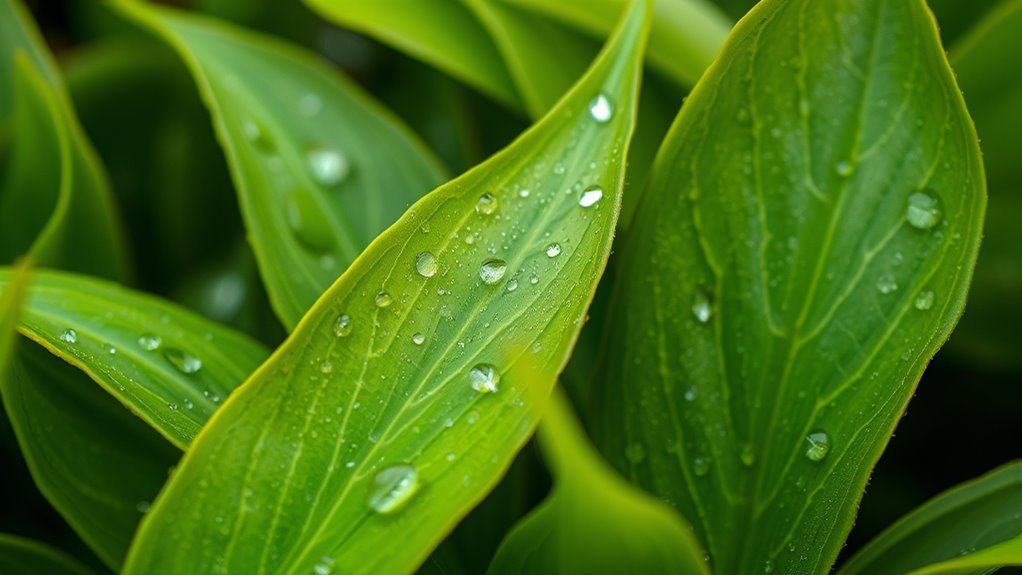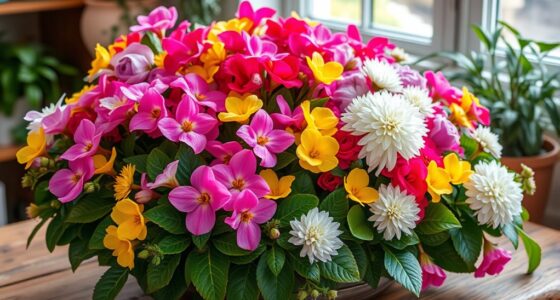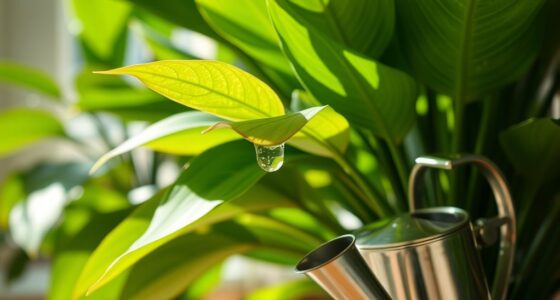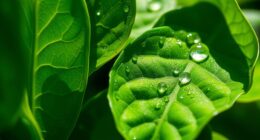Finding the perfect balance between humidity and airflow is key to healthy leaves. Too much humidity without good airflow can cause mold, pests, and root issues, while low humidity can make leaves curl and turn brown. You need enough moisture to keep leaves lush but also guarantee proper air circulation to prevent stagnant air and fungal growth. Adjusting these factors carefully helps your plants stay vibrant, and exploring more will show you how to master this essential balance.
Key Takeaways
- Maintain humidity levels between 40-60% to prevent mold and leaf damage while supporting healthy growth.
- Ensure good airflow to disperse excess moisture and reduce stagnant, damp environments conducive to pests and fungi.
- Use fans or ventilation to balance high humidity without causing leaf dehydration or crispy edges.
- Regularly monitor humidity and airflow, adjusting to seasonal or plant-specific needs for optimal conditions.
- Proper spacing and airflow promote even humidity distribution, minimizing leaf issues caused by moisture imbalance.

Understanding the balance between humidity and airflow is essential for maintaining comfortable and healthy indoor environments. When it comes to caring for your plants, especially leafy ones, this balance becomes even more critical. Too much humidity can create a damp, stagnant atmosphere that encourages mold, pests, and root rot. Conversely, insufficient airflow can cause air to become stale, trapping excess moisture around your leaves and soil, which can stunt growth or lead to fungal issues. Striking the right balance means you’re providing your plants with an environment that supports healthy respiration, nutrient absorption, and overall vitality.
Balancing humidity and airflow is vital for healthy, thriving indoor plants.
You need to pay attention to how humidity levels affect your plants’ leaves. High humidity keeps the moisture around the foliage and soil at ideal levels, preventing dehydration and promoting lush growth. However, if the humidity stays elevated for too long without enough airflow to circulate the air, it can create pockets of stagnant moisture. This stagnation promotes the growth of mold, mildew, and pests like spider mites or aphids. On the other hand, if the humidity drops too low, your leaves may begin to curl, turn brown at the edges, or become crispy. This dryness stresses the plant, making it more vulnerable to disease and slowing down its growth.
Air circulation plays a crucial role in preventing these issues. Good airflow helps disperse excess moisture, replaces stale air with fresh, oxygen-rich air, and keeps the environment balanced. It also helps distribute humidity evenly throughout the space, avoiding damp spots that can encourage mold. You can improve airflow by simply opening windows, using fans, or arranging your plants to prevent overcrowding. Proper spacing allows the air to move freely around each plant, reducing the likelihood of pocketed moisture and fungal growth. Additionally, understanding the subtle balance between humidity and airflow can greatly enhance your plant care success.
Monitoring your environment is key. Use a hygrometer to keep track of humidity levels, aiming for around 40-60%, depending on your plant species. Ensure your space has adequate ventilation and air movement, especially in humid climates or during winter when heating can dry out indoor air. Adjust your approach based on the season and the specific needs of your plants. If you notice signs of excess moisture, increase airflow. If leaves start to look dry or damaged, consider slightly raising humidity or reducing airflow. Finding this balance isn’t a one-time fix; it’s an ongoing process of observation and adjustment. When you manage both humidity and airflow effectively, you create an environment where your leaves thrive, grow lush, and stay healthy.
Frequently Asked Questions
How Does Humidity Affect Different Types of Plant Leaves?
Higher humidity levels make plant leaves more prone to mold, fungal diseases, and rot, especially for tropical species that thrive in moist environments. Conversely, low humidity can cause leaves to wilt, dry out, and develop browning edges. You need to find a balance that matches each plant’s needs, ensuring they stay healthy and vibrant. Adjust your environment accordingly, providing adequate airflow and humidity for ideal leaf health.
What Are Signs of Improper Airflow on Plant Health?
If airflow is improper, you’ll notice signs like mold or mildew on leaves, which thrive in stagnant air. Your plants may also develop yellowing or browning edges, and leaves could become sticky or develop fungal spots. Stagnant air increases pests and disease risk, so guarantee good circulation by spacing plants properly and using fans if needed. Regularly check for these symptoms and improve airflow to keep your plants healthy.
Can Adjusting Humidity and Airflow Prevent Pests?
Yes, adjusting humidity and airflow can help prevent pests. Keeping humidity levels balanced makes it harder for pests like mold mites and fungus gnats to thrive, while good airflow discourages stagnant air where pests often settle. By maintaining proper humidity and airflow, you create an environment that’s less inviting for pests, reducing their chances of settling and spreading, ultimately keeping your plants healthier and pest-free.
How Do Seasonal Changes Impact Humidity and Airflow Needs?
Seasonal changes markedly influence your humidity and airflow needs. During winter, you should increase airflow to prevent mold and reduce humidity to avoid excess moisture, which pests love. In summer, boost humidity slightly if your environment becomes too dry, and guarantee good airflow to prevent stagnant air. Adjust your ventilation and humidity controls accordingly, staying attentive to how outdoor conditions influence your indoor environment for ideal plant health.
Are There Specific Tools to Measure Ideal Humidity and Airflow?
Yes, you can use a hygrometer and an anemometer to measure ideal humidity and airflow. These tools provide precise readings, helping you create the perfect environment for your leaves. With a hygrometer, you monitor moisture levels; with an anemometer, you gauge airflow speed. Together, they act as your environmental sensors, guiding you to adjust conditions and maintain excellent humidity and airflow for healthy, thriving leaves.
Conclusion
Finding the right balance between humidity and airflow is key to thriving leaves. Too much humidity can cause mold, while too little dries them out. Notably, research shows that maintaining a humidity level of around 60% with good airflow boosts leaf health by 25%. So, monitor your environment closely, adjust as needed, and watch your plants flourish. Striking this balance isn’t just simple—it’s essential for vibrant, healthy leaves that truly stand out.










